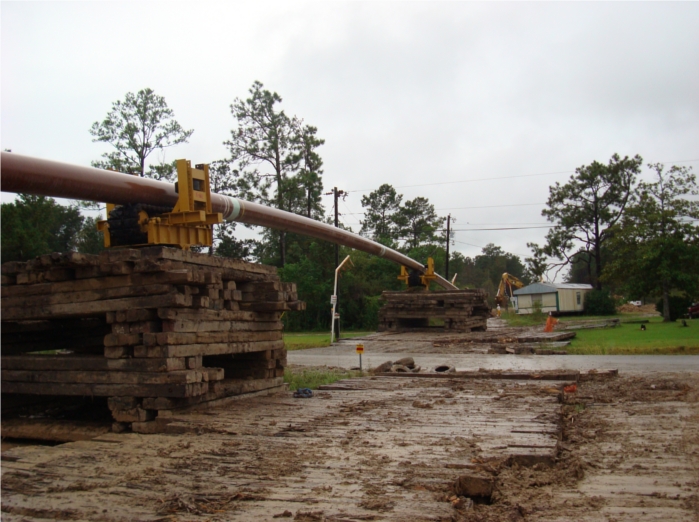January 2010 Vol. 237 No. 1
Features
Crossing For 320-Mile CO2 Pipeline Challenges New HDD Company And Crew

Starting a new horizontal directional drilling company in the current economic conditions can be challenging, but John Dagenhart has seen the ups and downs of this industry during his 18-year career in the trenchless industry and is using this experience to help guide his newly formed company.
Dagenhart formed Lone Star Directional Drilling, Clarksville, TX, in March after spending most of his career with Laney Directional Drilling. He worked in every facet of the business at Laney from surveying to drilling and finally supervising. He hopes his experience — along with that of partners, Steve Raulston and Paula Higgins, who have a background in distribution and procurement — will help guide the new business. So far the strategy is working well.
“The biggest change I’ve seen in my career is that the process has become much faster,” said Dagenhart. “Technology has allowed us to speed up the surveying, drilling and installation process, while offering more accuracy. It’s been a great ride, but it’s also a challenge keeping up with the new advancements.”
These advancements are playing into Dagenhart’s hand as the company focuses mainly on the installation of large-diameter pipelines, and new technology is more prevalent in this aspect of the industry than any other. With that in mind, Dagenhart set out to purchase his first drill and didn’t look much further than Vermeer. He bought a D1000x900 Navigator® horizontal directional drill from Vermeer Equipment of Texas.
“I was familiar with the HRE product line that Vermeer acquired,” said Dagenhart. “In fact, we used those machines when I worked for Laney. I was always impressed with the HRE design and machine reliability and really liked the enhancements Vermeer made to the product line they acquired. This maxi-rig is built ready to go to work, and that’s what I needed as a startup.”
One of the recent projects completed by Lone Star Directional Drilling was the installation of a 24-inch steel pipeline under a river. The 320-mile Green Pipeline, stretching from Donaldsonville, LA to Houston is being installed by Denbury Resources to transport both natural and man-made CO2 that will be injected into oil reservoirs to recover additional crude oil from depleted fields. The pipeline will have the capacity to transport up to 800 MMscf/d of CO2.
Dagenhart said the CO2 acts like a solvent, removing the oil from formations in the rock, helping to recover previously unattainable oil from existing fields.
Dagenhart was hired to install 4,148 feet of the 24-inch pipeline under the West Fork Calcasieu River just off of Highway 27 north of Sulphur, LA in the southwest portion of the state. The Calcasieu is a small river that runs southwesterly into Calcasieu Lake. The river features port facilities in and around the nearby city of Lake Charles and serves primarily as access to fishing and hunting areas in adjacent lakes, bayous, wetlands and the Gulf of Mexico.
As with any river crossing project, Dagenhart anticipated hitting cobble and fine gravel and estimated the deposits would be about 65 feet deep on the entry and exit sides of the bore.
“We set up the drill rig about 2,000 feet from the river and began our pilot bore on Sept. 1,” said Dagenhart. “We decided to go deeper than normal to avoid the cobble, so we bored straight down through the cobble to minimize its effect on our drill plan. At about 400 feet into the bore we broke through the cobble layer.”
Dagenhart used an 8.75-inch mill tooth regular drill bit for the pilot bore. On the second day, the crew had completed 1,500 feet of the pilot bore and on the afternoon of Sept. 4 the pilot bore was completed. The crew bored to a final depth of 86 feet to avoid the cobble and ensure they had the required 30 feet of cover below the river bottom.
Sept. 5, was spent preparing for the backream process. Once the drill assembly was removed, 24-inch and 36-inch butterfly reamers were used to pre-ream the hole. The pre-ream process began on Sept. 6 and took five days to complete. This was followed by a pass with a 30-inch swab which was completed in one day.
“The swab looked perfect and we didn’t see anything in the hole, so we took a day off and then started pulling the pipeline back,” said Dagenhart.
The biggest challenge of the project was the pipeline itself.
The project was located in the heart of Sulphur and U.S. Pipeline, Inc., the pipeline contractor, had to address some significant restricted space issues. In fact, the pipeline weaved through the town, crossing two highways and meandering through local neighborhoods. Closing down roads wasn’t an option, so U.S. Pipeline had to install pipe rollers on both sides of the highways in order to suspend the pipeline string above the road and not impede traffic flow.
“It was quite a sight for the local residents, but U.S. Pipeline did a great job overcoming this challenge, and their efforts and extra work really helped keep this project on schedule,” said Dagenhart.
Dagenhart said the crew hooked onto the pipeline string, but had to pull it about 300 feet up to the entry hole before the actual pullback began. By noon on Sept. 14, the pullback began and by 5:30 p.m. the pipe had been installed.
“Like I said, technology and ingenuity are rapidly changing our industry,” said Dagenhart. “The best-laid plans can always get changed on the jobsite due to an unexpected circumstance. But, we know our experience could overcome those challenges and the outcome was perfect.”





Comments